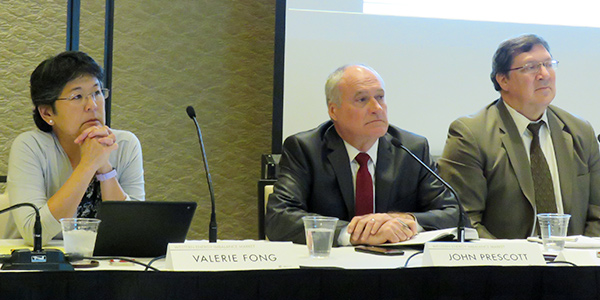The Western Energy Imbalance Market’s Governing Body approved two CAISO measures and endorsed a third measure Wednesday to improve reliability and lessen the chances that the West will be hit with capacity shortfalls again this summer.
The Governing Body has primary approval authority over two of the measures, which affect the EIM. One would enhance testing to make sure balancing authority areas in the EIM have sufficient resources. Another would improve coordination among the BAAs.
The third measure deals with scarcity pricing under strained system conditions; the EIM’s role was advisory. (See related story, CAISO MSC Weighs Summer Market Changes.)
The CAISO Board of Governors must still approve all three measures at its meetings on March 24 and 25. They are part of the summer readiness initiatives that CAISO fast-tracked in response to the rolling blackouts in mid-August and issues identified in a root-cause analysis of the events.
A separate resource adequacy initiative is also moving forward, which CAISO hopes will be approved later this month. (CAISO Readies RA Enhancements for Summer.)
With only three months to weigh the measures, not everything stakeholders – or even CAISO – wanted is included, but the process will continue in future phases, Anna McKenna, the ISO’s interim vice president for market policy and performance, told EIM Governing Body members.
“We found it was necessary to move forward at this time with the changes we knew we could implement for this summer,” McKenna said. “The changes we present to you today we know are feasible both for ourselves and, we believe, for market participants.”
In her memo to the Governing Body, McKenna said the resource sufficiency enhancement will help ensure that each BAA participating in the EIM can meet its own load and will prevent participants from “leaning” on the EIM, an interstate real-time energy market.
The current resource sufficiency evaluation includes two tests: a capacity test and a flexible ramping sufficiency test. The tests need upgrades to deal with the situation that gave rise to the August blackouts, when solar ramped down in the evening, she said. The tests showed CAISO had sufficient resources prior to the blackouts even though it was running short.
In response, “management proposes to enhance the EIM’s resource sufficiency evaluation’s capacity test so that it accounts for net load uncertainty in addition to each balancing authority area’s net load forecast,” the memo said. Net load is demand minus renewable resources, primarily solar. The August blackouts occurred at roughly 6:30 p.m., as solar generation steeply declined.
“Actual net load can be significantly different than forecast, particularly with significant amounts of renewable resources,” it said. “For example, an unexpected sudden decrease in solar output increases the net load that must be met by dispatchable resources.”
CAISO management wants to improve the capacity test “to require each balancing authority area to submit sufficient energy schedules and bids to account for net load forecast uncertainty, in addition to sufficient schedules and bids to cover its forecast load,” McKenna wrote. “This will better ensure each balancing authority provides sufficient schedules and bids and the associated resource capacity to meet its actual net load, including net load that may be different than forecast.”
The flexible ramping test accounts for some net load uncertainty, “but it only looks at ramp rate capability between market intervals and consequently does not ensure each balancing authority area has sufficient overall capacity based on its resource schedules and energy bids to meet its forecast net load and account for net load uncertainty,” the staff memo noted.
“The net load uncertainty amount used in the resource sufficiency evaluation is determined by similar principles that the ISO market systems use for the real-time market’s flexible ramping product procurement,” it said. “The requirement accounts for the net load forecast error between the fiftee15-minute and 5-minute real-time market dispatch. This amount is adjusted [in the proposed changes] to reflect the diversity benefit of meeting net load uncertainty across the EIM with one set of resources.”
‘Step in the Right Direction’
CAISO management also proposed “an enhancement related to how the real-time market models energy interchanges into the ISO balancing authority areas at intertie scheduling points that are sourced from adjacent balancing authority areas in the EIM.” The measure came from CAISO’s review of operations during last summer’s heat waves in which the ISO’s market systems and EIM BAA used incorrect information, it said.
“Management proposes to make it mandatory for EIM balancing authority areas to use an automated market feature that updates the EIM balancing authority area’s ‘mirror resource’ when the ISO market awards an import at an ISO intertie scheduling point that was sourced from the EIM balancing area,” McKenna’s memo said. “These are separate from EIM transfers resulting from the EIM’s resource-specific dispatch.”
Mirror resources model the energy interchange from EIM balancing authority area, the ISO said. “An oversight in updating a mirror resource’s schedule during tight conditions last summer resulted in system anomalies and operational issues,” it said.
The Governing Body unanimously approved the resource sufficiency and BAA coordination measures and recommended that the ISO Board of Governors adopt the scarcity pricing component.
During Wednesday’s discussion, CAISO CEO Elliot Mainzer said the summer readiness enhancements are key to the future success of CAISO and the EIM.
“The sufficiency elements of the EIM are just absolutely foundational, and there should be no question whatsoever that we are unequivocally committed to addressing the issues that we found last year,” Mainzer said. “These initial sets of changes are a step in the right direction, but we recognize it’s not the end of the conversation, both for 2021 and beyond.”




